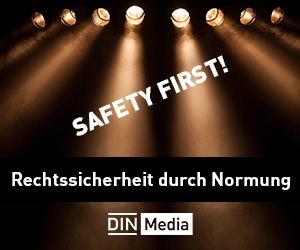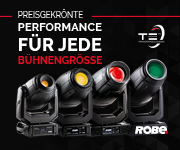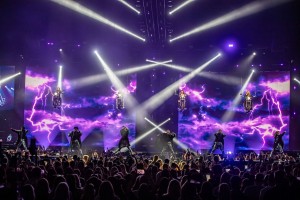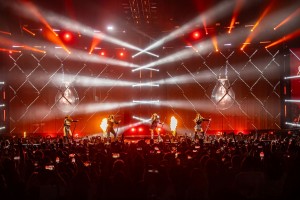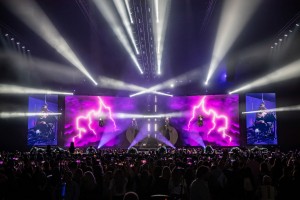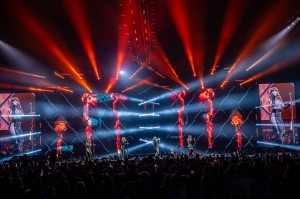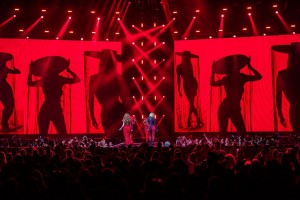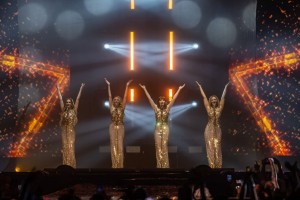Aktuelle News & Schlagzeilen
PRG helps deliver Girls Aloud tour production
This spring, Girls Aloud were back on the road for the first time in eleven years, with their “Girls Aloud Show” tour in May and June, creatively directed by Beth Honan and lit by Peter Barnes. Lighting, video, automation and rigging equipment - including some new innovations - and crew were supplied by PRG UK to Production North, whose Iain Whitehead was overseeing all related technical production elements for the first leg of the tour that played UK and Irish arenas including five sold out nights at London’s O2.
PRG UK’s account manager Yvonne Donnelly was co-ordinating everything. “It’s been an absolute pleasure collaborating with Iain and the creative team again on this groundbreaking tour for PRG, showcasing our newly developed RollCat tracking system alongside some of our tried and tested proprietary Icon range and with Ground Control running our newly developed VL3600 follow spots”, she states.
Lighting designer Peter Barnes first worked with Girls Aloud in 2005, also lit the last “Ten: The Hits” tour in 2013 and has worked with Beth Honan on a variety of other projects over several years. Honan, responsible for the choreography, already had some clear ideas about how the stage should look, says Barnes. She wanted a clean, modern space with an epic widescreen presence and a nod to fashion show aesthetics in the form of a thrust and a B-stage to get the Girls physically out amongst their fans.
Honan envisioned the two large video screens with a bold strip of light striking through the runway area, the latter translating into two spine trusses flown above the thrust. Barnes used the two 10.8-metre-wide by 7.2-metre-high onstage screens and the 30-metre-long thrust as the starting points for the production lighting design.
The challenge, with this scenography in place, was in getting more overhead lighting positions. The 25 metres of RollCat tracking truss - a PRG proprietary product manufactured by Moveket - rigged centrally, running the length of the thrust, and utilised for a hi-impact motorbike flying stunt at the start of the show’s second section meant that nothing apart from the two exiting spine trusses could be added here.
Upstage centre, in the gap between the two onstage screens, were four trussing towers that continued the line of lighting positions. At the offstage edges of these two onstage screens were two more trussing towers, and these six architectural elements offered some excellent lighting positions for creating effects and looks as well as for the practical purpose of lighting the stage and artists. The towers were also newly purchased by PRG, coming in 1 and 2 metre sections, and packed down into dollies for travel, which was expedient on truck space in Lighting’s three fully packed artics.
Above and upstage of the main screens each side Barnes persuaded Honan that a double array of standard trussing runs should be added to assist in lighting the 60 ft wide stage as doing this just from a 10 ft wide central spine would have been extremely challenging. Both front and back rails on these trusses were used for over and under-slung lighting fixtures which accentuated the depth. All these trusses were rigged with PRG’s proprietary Icon Edge multi-functional moving light fixtures, which were the workhorses of this design.
Mirroring the thrust “spine” trusses in far offstage stage positions were two (left and right) trusses, also rigged with Icon Edges together with some Robe Spiider LED wash fixtures to assist in key lighting along the runway positions and for blasting out into the audience for the interactive moments. A short advance truss in front of the end of the runway was rigged with five Vari-Lite 3600s all running on four (+ 1 spare) PRG Ground Control remote follow spot systems.
The V-L 3600 is the latest fixture now supported by the Ground Control platform. The Ground Control base stations were located stage right and operated by four of the tour’s twelve truck drivers. Ground Control is also lighting director/operator Chris Scott’s first choice for remote follow spot control. All the metalwork was black or masked in keeping with the streamlined aesthetic.
The floor was left relatively clear of lights apart from a row of Vari-Lite 3600s and an array of Solaris strobe/floods right along the back. The Icon Edges were dotted all over the trusses, up the centre double towers and the outside screen framing towers, on the back array trusses, on the spine trusses above the runway and the side trusses, a total of 68 luminaires. They were the backbone of all the big production looks and enabled Barnes and programmer Jake Humphries to construct a diverse range of scenes and effects to keep the pace pumping throughout the 90-minute set.
The fixture choice also included 20 Robe Spiiders for the side trusses, 22 GLP X4 LED battens on the back trusses and 16 Vari-Lite 3600s including the five follow spots. Seventy 3-metre ACME Pixel Line LED battens were used to create pixel-mappable vertical lines of light shooting up the back towers and along the length of the runway trusses, with a double row framing the top of the main screens and a single row running down their outer edges. These were programmed to bring another layer of fluid and dramatic kinetic movement to the action, while eighteen Roxx 4-lite blinders graced the side trusses for additional audience and runway highlighting.
Barnes and his team spent five days of pre-vis at Zeal Live in Basingstoke, followed by five days of full production rehearsals on the George Lucas Stage at Elstree, where they were joined by Chris Scott and together finessed the initial building blocks, developed the show and programmed the GrandMA3 full size console which was running in full GM3 mode.
The show was a balance of key lighting, dramatic effects and big looks rich with colour and movement that blended with the video content, show narrative and choreography. In addition to lighting the Girls and their ten dancers, there was constantly something interesting happening back of shot for the IMAG mix. It was Chris Scott’s first time working with Barnes after being recommended for the job by Yvonne Donnelly at PRG where he worked full time for many years in the events department. Scott has been running in all GrandMA3 mode for a couple of years now and loves features like Recipes, which were used extensively on this show.
The lighting control network was made up of PRG SuperNodes and Limicore LumiNodes. Scott enjoyed working with “a brilliant team” including PRG crew chief Alex Peters, Colm Robinson who was looking after dimmers, and lighting techs Dominic White and Stuart Wright. Like Scott, lighting crew chief Alex Peters is also now freelancing after working full time for PRG for twelve years, and for him the most galvanising task was coordinating the daily logistics of getting the show in and ensuring the build ran smoothly and efficiently.
The length of the central spine meant trusses had to be constructed in a specific order which consumed all floorspace in an average sized arena, putting lighting “in front” of the automation and video departments, requiring serious coordination so everyone could work simultaneously and without encroachment. A few shows into the tour, and the process was down to a fine art, allowing the stage to be rolled in at around midday. The central spine trusses also had to line up perfectly to be picked up and flown on the Mothergrid, which facilitated 112 hanging points across all departments for the largest shows on the itinerary. Head rigger was Zack Wade.
Automation is still on-trend for live shows and a key is not to over-use it as a vehicle for theatrical performance, and “The Girls Aloud Show” is a good example. Another recent PRG investment has been into substantial amounts of new Moveket automation equipment, some of which was out on this tour, including the RollCat tracking truss, all overseen on the road by Peter MacDonald.
PRG’s Mark Wade dealt with the tour’s original automation requirements and specified the system which was based around Moveket i-Motion winches, the VMS-S 125-3-30. The main motorbike flying stunt happened as the Girls went into “Wake Me Up” - masked by lighting and smoke, they suddenly popped up at the back of the stage on the bikes, each one picked up by three winches. Positioned five metres apart, the four bikes were tracked 25 metres down to the end of the runway where they soft-landed on the stage and the girls alighted.
The twelve Moveket winches were positioned in trussing in the roof with their drive units all upstage on the floor. As the travel distances allowed this to happen, it made sense to have the brains of the system fully accessible. The decision to go with winches as opposed to chain hoists was a creative one, driven by winch wires being a lot less visible. The winches were also used for flying four platforms on which the Girls started the show rising up from the floor, and again to fly the Hologauze curtain for the encore projections.
All the automation cues were run via a Moveket i-Motion Expert III console. To ensure that nothing was left to chance, as the Girls were getting into position on the bikes, two spotters onstage had eyes on everything, while others were involved with clipping them securely into their harnesses.
Some show cues were run manually, others were timecode triggered from the audio track. The biggest challenge for Barnes and his team - comprising Will Gallegos and Thijs Verplaetse who came from PRG Belgium with the Moveket system - was making sure that everything was rigged and ready in the available time. The video department was headed up by Stevie Marr and included the only female member of the tech team, Izzy Everatt, who has been working full time at PRG for the last five years and in the video department for two and a half of those.
The screens were all made up from new Infiled products, part of another recent larger purchase of LED screen assets by PRG. The two centre ones were made up from Infiled’s Titan-X 8.3 mm product, and they were flanked by the two portrait IMAG screens at 7 metres tall by 4 metres wide, built from Infiled AR P4. The screens were crucial to both the physical scenography and the show narrative with a mix of playback content - stored on two new Pixera media servers - and IMAG footage. The content brought some 3D reality to the performance. It was created by Neil Harris, Caspar Wain and Jos Taylor from motion design specialists Shop, working closely with Honan.
Izzy Everatt programmed the servers during rehearsals together with PRG’s James Hancock, and then she was tech’ing them on the road. All the playback content was timecode cued from the audio backing track. It included extensive footage of fifth Girls Aloud member, the late Sarah Harding, who passed away in 2021. A four-camera package of Sony HXC 300s were utilised for a fast mix cut by Ivan Youlden using a BMD (Black Magic Design) Atem Constellation 4 M/E switcher. Two of the cameras were positioned in the pit, fitted with wide angle lenses, and two at FOH for long shots.
During the encore, a Hologauze dropped in across the stage. Girls Aloud stood behind this with projections beamed onto the front from a Barco UDM 4K30 projector fitted with a UDX 9.38 90-degree (periscope) lens which covered the 4 metre ultra-wide throw to the surface. The projector, tech’d by Mike Dorrie, popped up from a trap door to the side of one of the B stage walkways, helping to bring the show to a theatrical close.
(Photos: Louise Stickland/Paul Clarke)
SCHLAGZEILEN
news archiv
suche
© 1999 - 2025 Entertainment Technology Press Limited News Stories

